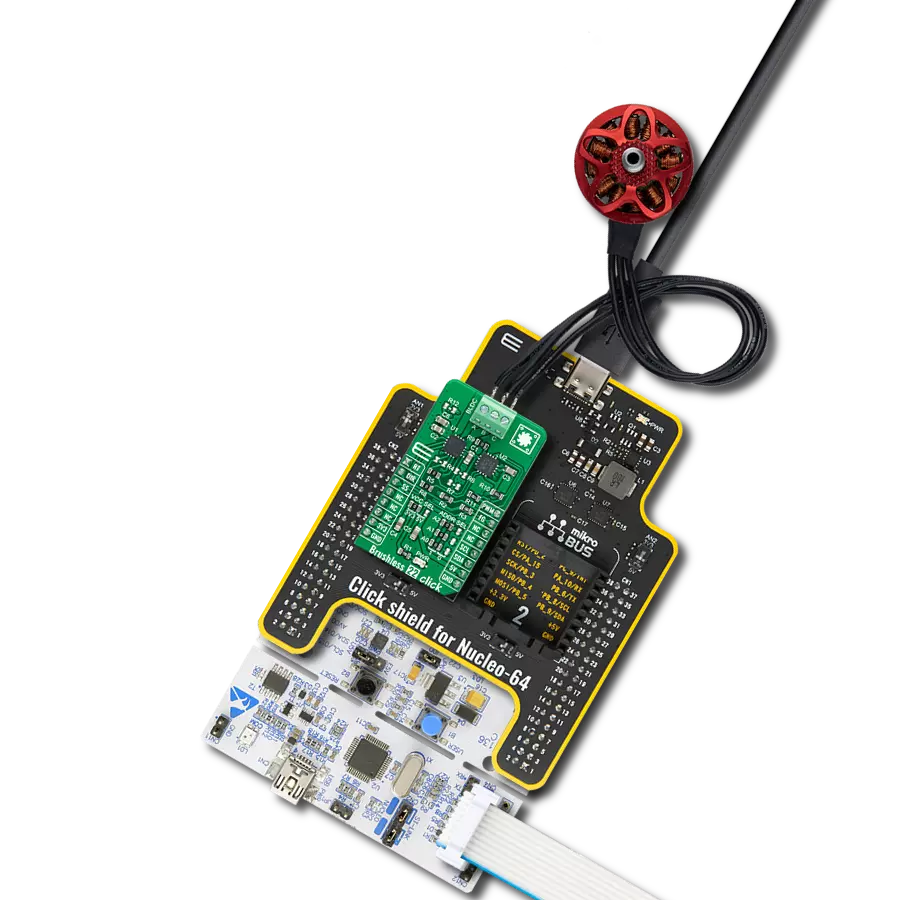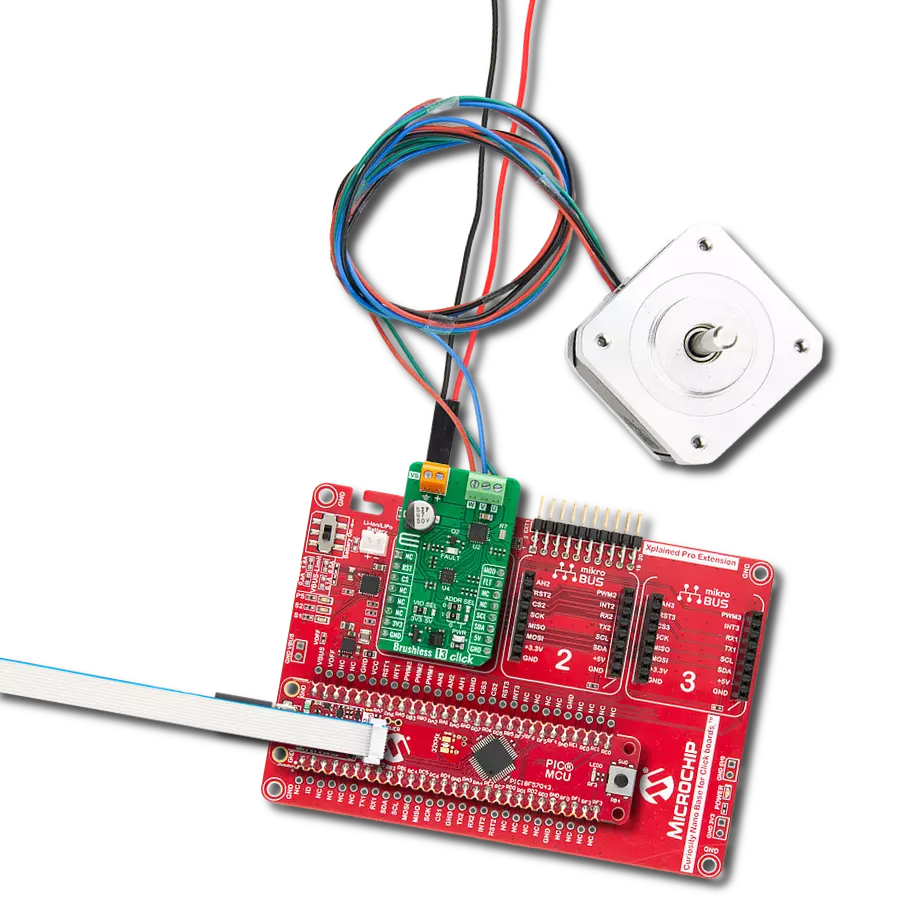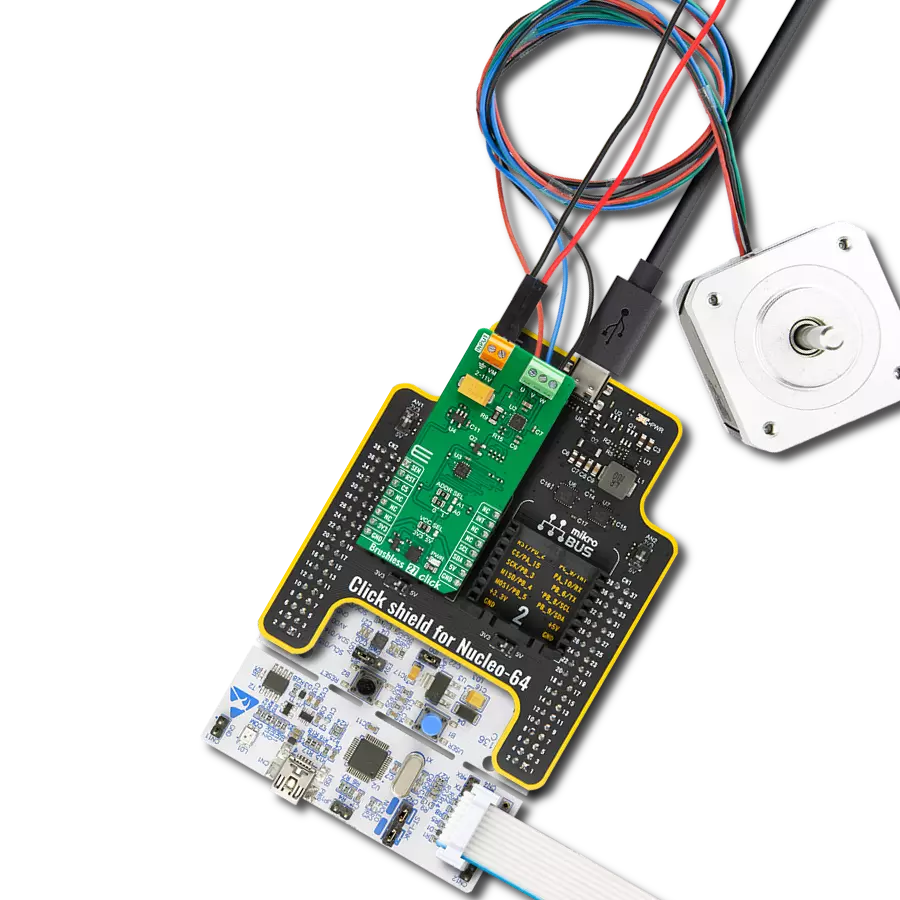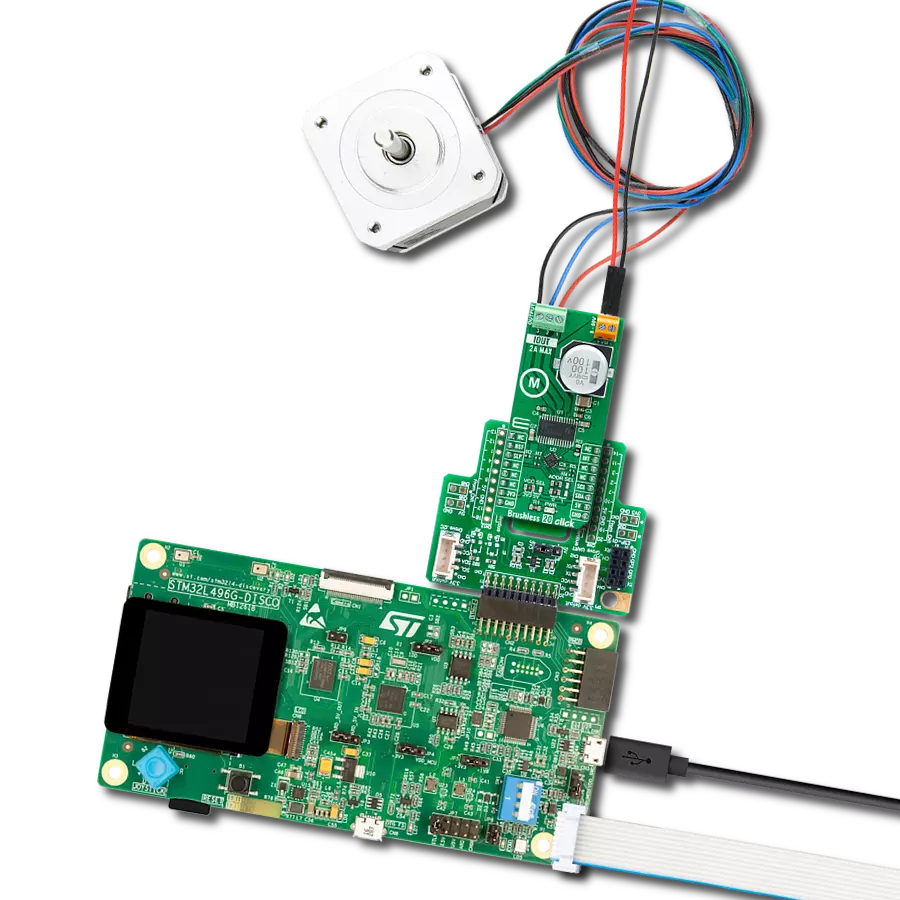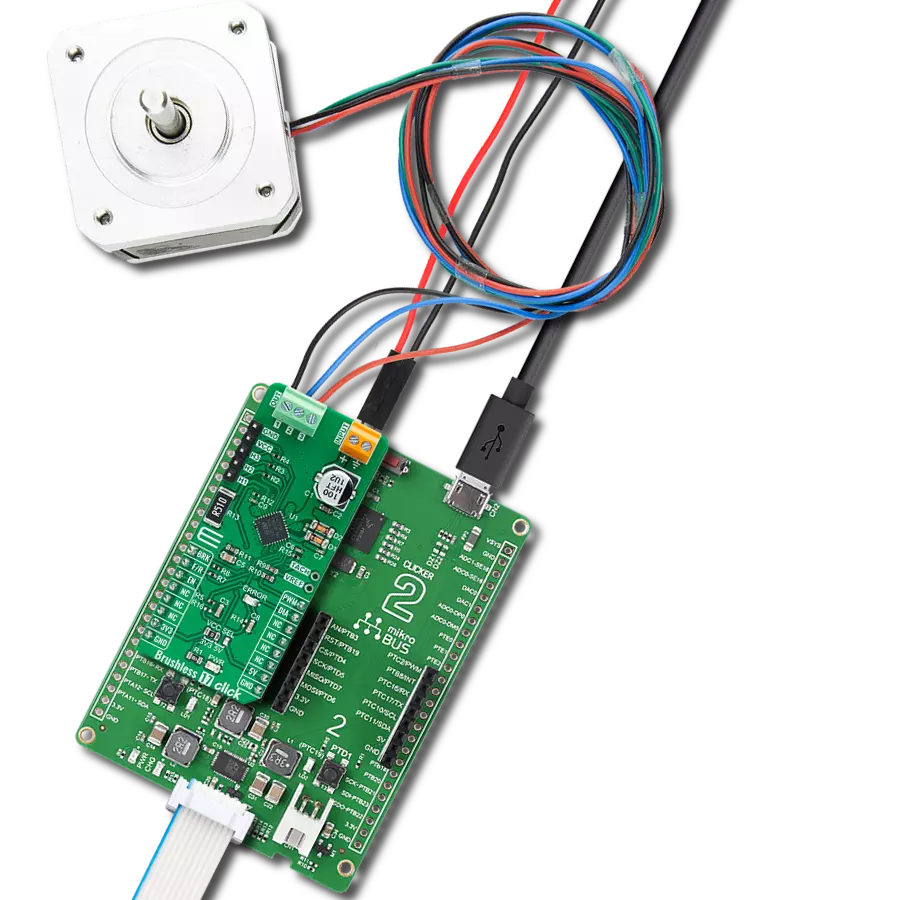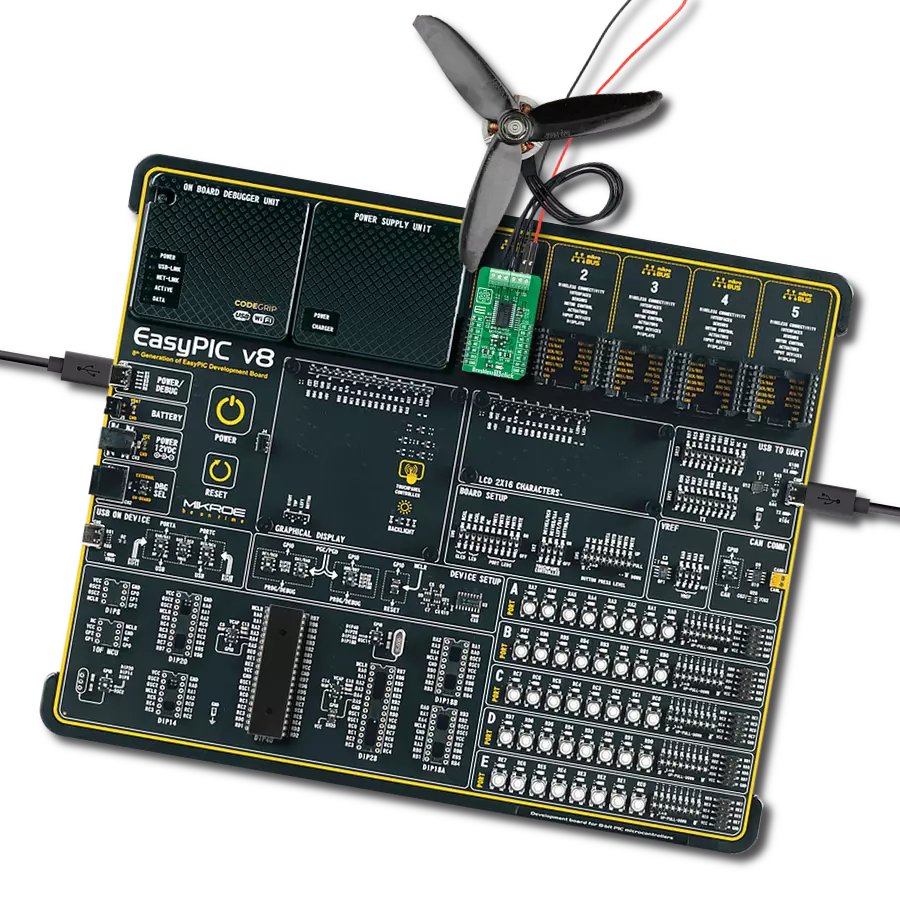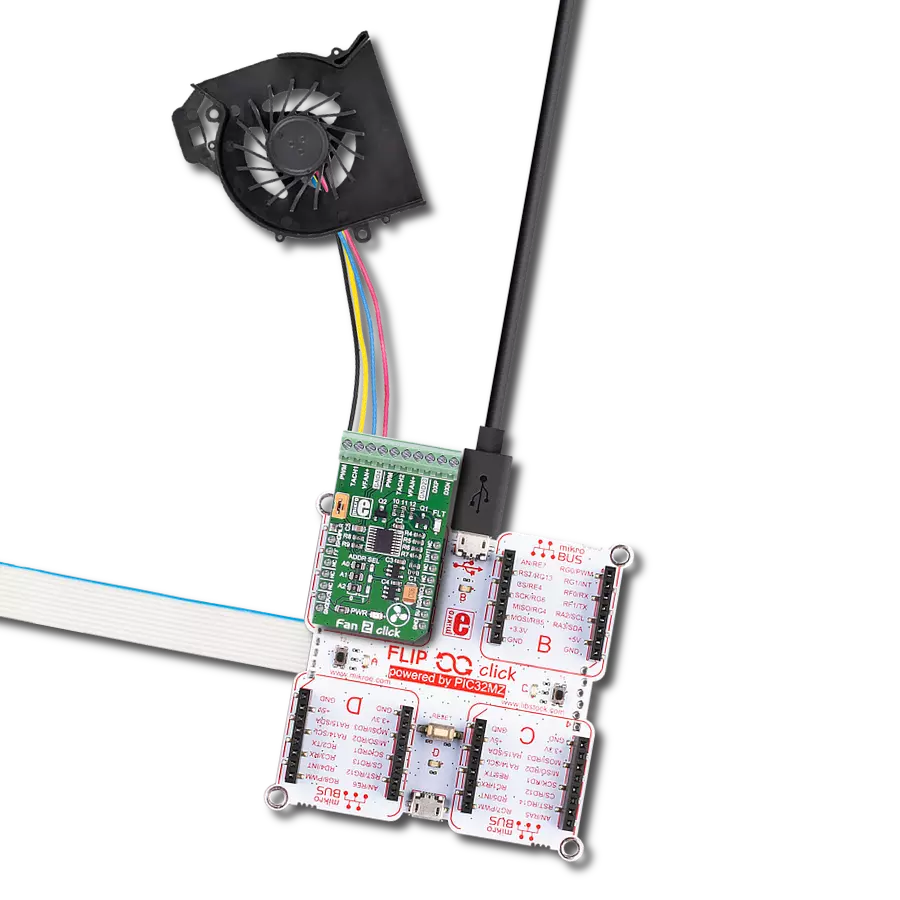Harness AI-powered precision with our next-gen brushless motor control solution
A
A
Hardware Overview
How does it work?
Brushless 24 Click is based on the DRV10866, a fully integrated three-phase BLDC motor driver from Texas Instruments. The DRV10866 motor driver comes with integrated power MOSFETs with current drive capability up to 800mA peak (based on populated 3.9k resistor), specifically designed for low-noise energy-saving fan motor drive applications connected to the terminals labeled as U, V, W, and COM. It provides PWM/enable control interface (PWM pin of the mikroBUS™ socket), wide operating voltage range, robust on-chip protection features, low RDSON, and efficient switching algorithms to ensure excellent thermal performance and high drive capability. The DRV10866 implements a 150° commutation (sensorless BEMF control scheme) for
a 3-phase motor alongside a synchronous rectification mode of operation that achieves increased efficiency for motor driver applications. In addition, the DRV10866 has a frequency generator pin (FG) that outputs a 50% duty cycle of PWM waveform in the normal operation condition. The FG represents the motor speed and phase information, detectable through an interrupt pin of the mikroBUS™ socket and a blue LED indicator marked as FG. During the Start-Up sequence, the FG output will stay at high impedance until the motor speed reaches a certain level and BEMF is detected, while during lock protection conditions, the FG will remain high until the motor restarts and the Start-Up process is completed. Apart from this function, the
DRV10866 can also output either full FG or half of the FG to indicate motor status with open-drain output through the FGS SEL selection jumper. When FGS SEL is placed in a VCC position, the FG output frequency is half that when the jumper is set to a GND position. The DRV10866 has multiple built-in protection blocks, including UVLO, overcurrent protection, lock protection, and thermal shutdown protection. This Click board™ can operate with either 3.3V or 5V logic voltage levels selected via the VCC SEL jumper. This way, both 3.3V and 5V capable MCUs can use the communication lines properly. This Click board™ comes equipped with a library containing easy-to-use functions and an example code that can be used, as a reference, for further development.
Features overview
Development board
PIC18F57Q43 Curiosity Nano evaluation kit is a cutting-edge hardware platform designed to evaluate microcontrollers within the PIC18-Q43 family. Central to its design is the inclusion of the powerful PIC18F57Q43 microcontroller (MCU), offering advanced functionalities and robust performance. Key features of this evaluation kit include a yellow user LED and a responsive
mechanical user switch, providing seamless interaction and testing. The provision for a 32.768kHz crystal footprint ensures precision timing capabilities. With an onboard debugger boasting a green power and status LED, programming and debugging become intuitive and efficient. Further enhancing its utility is the Virtual serial port (CDC) and a debug GPIO channel (DGI
GPIO), offering extensive connectivity options. Powered via USB, this kit boasts an adjustable target voltage feature facilitated by the MIC5353 LDO regulator, ensuring stable operation with an output voltage ranging from 1.8V to 5.1V, with a maximum output current of 500mA, subject to ambient temperature and voltage constraints.
Microcontroller Overview
MCU Card / MCU

Architecture
PIC
MCU Memory (KB)
128
Silicon Vendor
Microchip
Pin count
48
RAM (Bytes)
8196
You complete me!
Accessories
Curiosity Nano Base for Click boards is a versatile hardware extension platform created to streamline the integration between Curiosity Nano kits and extension boards, tailored explicitly for the mikroBUS™-standardized Click boards and Xplained Pro extension boards. This innovative base board (shield) offers seamless connectivity and expansion possibilities, simplifying experimentation and development. Key features include USB power compatibility from the Curiosity Nano kit, alongside an alternative external power input option for enhanced flexibility. The onboard Li-Ion/LiPo charger and management circuit ensure smooth operation for battery-powered applications, simplifying usage and management. Moreover, the base incorporates a fixed 3.3V PSU dedicated to target and mikroBUS™ power rails, alongside a fixed 5.0V boost converter catering to 5V power rails of mikroBUS™ sockets, providing stable power delivery for various connected devices.
Brushless DC (BLDC) Motor with a Hall sensor represents a high-performance motor from the 42BLF motor series. This motor, wired in a star configuration, boasts a Hall Effect angle of 120°, ensuring precise and reliable performance. With a compact motor length of 47mm and a lightweight design tipping the scales at just 0.29kg, this BLDC motor is engineered to meet your needs. Operating flawlessly at a voltage rating of 24VDC and a speed range of 4000 ± 10% RPM, this motor offers consistent and dependable power. It excels in a normal operational temperature range from -20 to +50°C, maintaining efficiency with a rated current of 1.9A. Also, this product seamlessly integrates with all Brushless Click boards™ and those that require BLDC motors with Hall sensors.
Used MCU Pins
mikroBUS™ mapper
Take a closer look
Click board™ Schematic

Step by step
Project assembly
Software Support
Library Description
This library contains API for Brushless 24 Click driver.
Key functions:
brushless24_set_duty_cycle- Brushless 24 sets PWM duty cyclebrushless24_pwm_start- Brushless 24 start PWM modulebrushless24_get_int_state- Brushless 24 get INT pin state
Open Source
Code example
The complete application code and a ready-to-use project are available through the NECTO Studio Package Manager for direct installation in the NECTO Studio. The application code can also be found on the MIKROE GitHub account.
/*!
* @file main.c
* @brief Brushless 24 Click example
*
* # Description
* This application is a schowcase of controlling speed of brushless motor using Brushless 24 Click.
*
* The demo application is composed of two sections :
*
* ## Application Init
* Initialization of LOG, PWM module and additional pins.
*
* ## Application Task
* In a span of second changes duty cycle from 0 to 100% which is changing speed of the motor.
*
* @author Stefan Ilic
*
*/
#include "board.h"
#include "log.h"
#include "brushless24.h"
static brushless24_t brushless24;
static log_t logger;
void application_init ( void )
{
log_cfg_t log_cfg; /**< Logger config object. */
brushless24_cfg_t brushless24_cfg; /**< Click config object. */
/**
* Logger initialization.
* Default baud rate: 115200
* Default log level: LOG_LEVEL_DEBUG
* @note If USB_UART_RX and USB_UART_TX
* are defined as HAL_PIN_NC, you will
* need to define them manually for log to work.
* See @b LOG_MAP_USB_UART macro definition for detailed explanation.
*/
LOG_MAP_USB_UART( log_cfg );
log_init( &logger, &log_cfg );
log_info( &logger, " Application Init " );
// Click initialization.
brushless24_cfg_setup( &brushless24_cfg );
BRUSHLESS24_MAP_MIKROBUS( brushless24_cfg, MIKROBUS_1 );
if ( PWM_ERROR == brushless24_init( &brushless24, &brushless24_cfg ) )
{
log_error( &logger, " Communication init." );
for ( ; ; );
}
if ( BRUSHLESS24_ERROR == brushless24_default_cfg ( &brushless24 ) )
{
log_error( &logger, " Default configuration." );
for ( ; ; );
}
log_info( &logger, " Application Task " );
}
void application_task ( void )
{
static int8_t duty_cnt = 1;
static int8_t duty_inc = 1;
float duty = duty_cnt / 10.0;
brushless24_set_duty_cycle ( &brushless24, duty );
log_printf( &logger, "> Duty: %d%%\r\n", ( uint16_t )( duty_cnt * 10 ) );
Delay_ms ( 1000 );
if ( 10 == duty_cnt )
{
duty_inc = -1;
}
else if ( 0 == duty_cnt )
{
duty_inc = 1;
}
duty_cnt += duty_inc;
}
int main ( void )
{
/* Do not remove this line or clock might not be set correctly. */
#ifdef PREINIT_SUPPORTED
preinit();
#endif
application_init( );
for ( ; ; )
{
application_task( );
}
return 0;
}
// ------------------------------------------------------------------------ END
Additional Support
Resources
Category:Brushless























